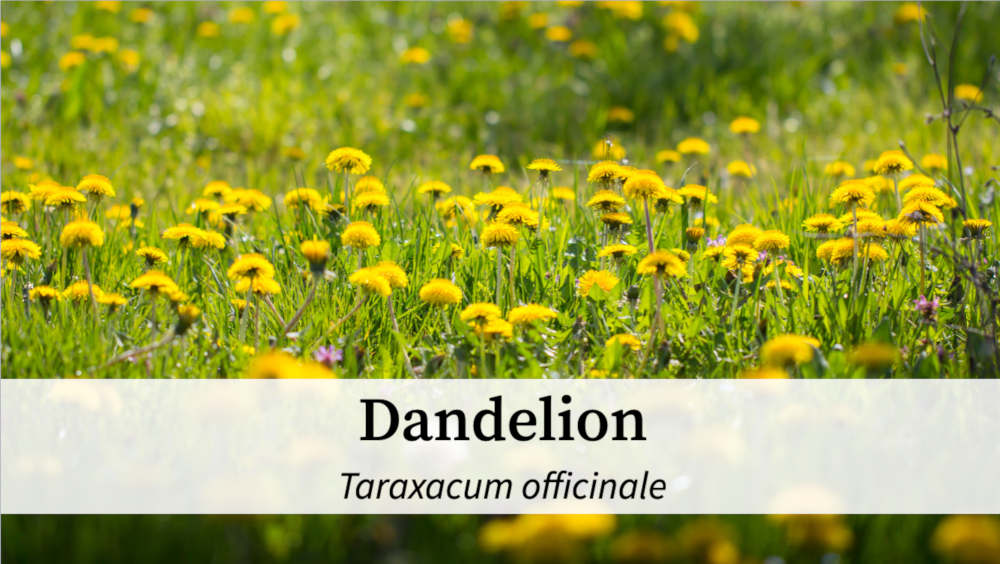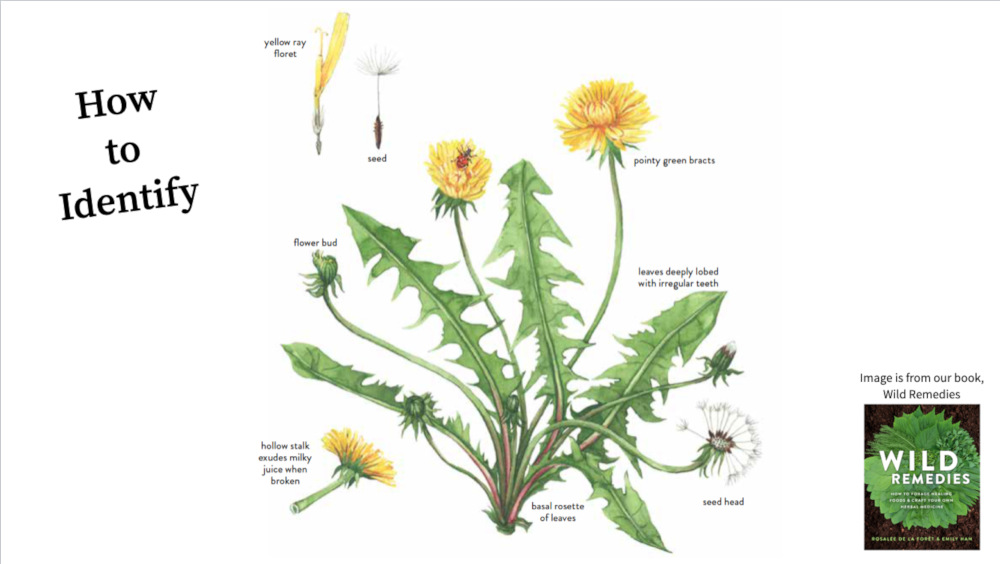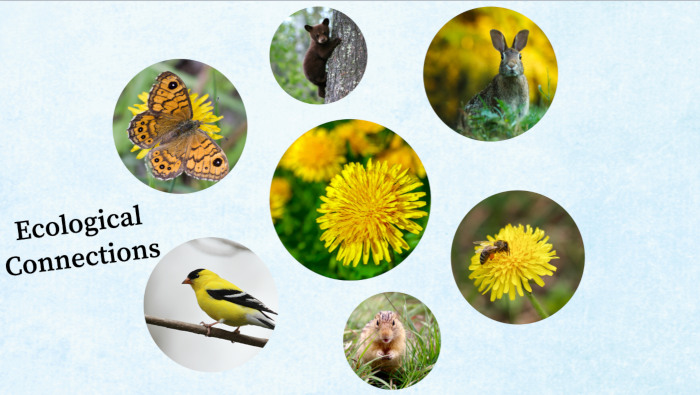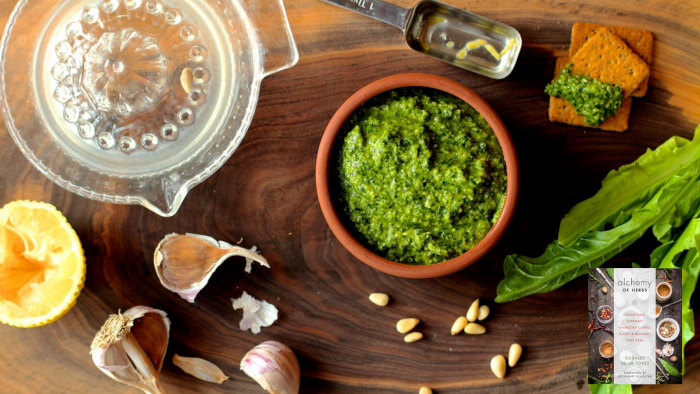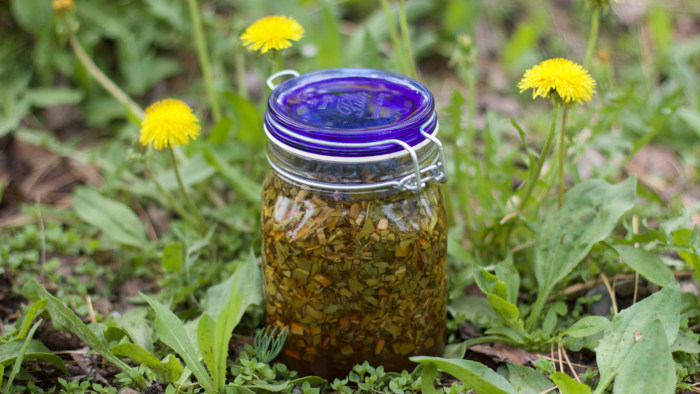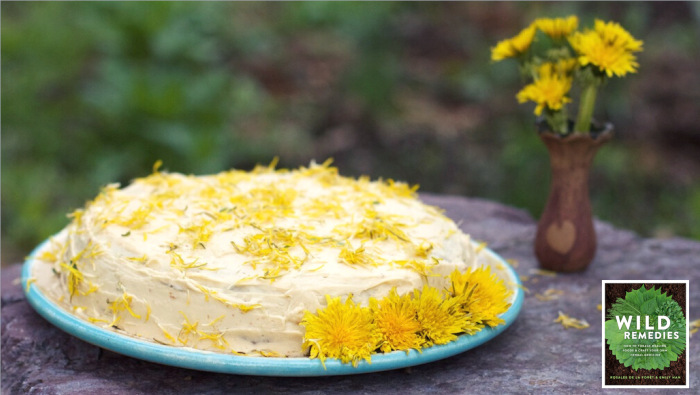Get weekly tips, recipes, and my Herbal Jumpstart e-course! Sign up for free today.
Dandelion Benefits and Dandelion Recipes
Share this! |
|
-- TIMESTAMPS --
00:00 - Introduction to dandelions (Taraxacum officinale)
02:09 - Dandelion energetics
03:07 - Benefits of dandelion greens
05:29 - Edible dandelion flowers are good for you
07:01 - How to identify dandelion
08:14 - Dandelion benefits in the ecosystem
08:42 - How to harvest dandelion
09:42 - Dandelion leaves recipes
11:05 - Dandelion flower recipes
Thanks for watching my Dandelion Benefits and Dandelion Recipes video!
Are you ready to make your own dandelion recipes?
There are two options for you to download your recipe cards.
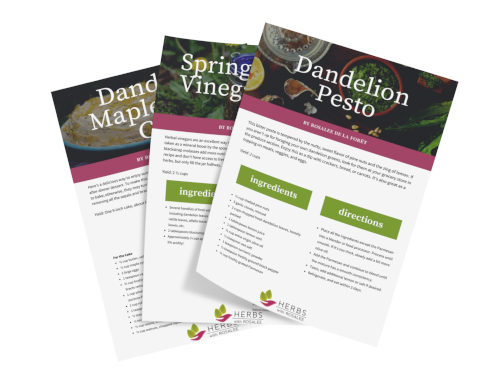
j
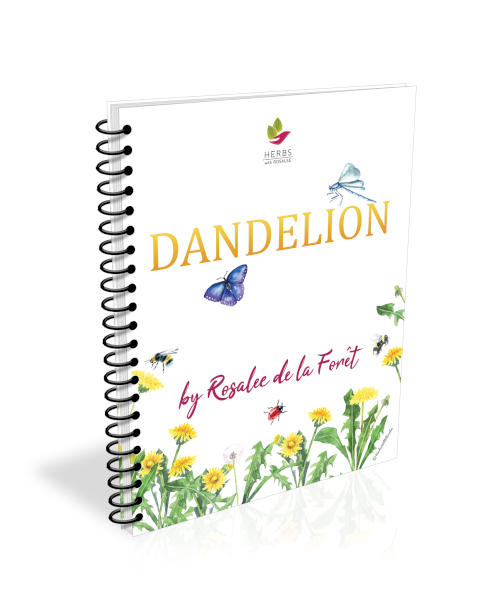
Yes! I would love the
Dandelion Recipe Cards
+
A beautiful Dandelion ebook.
Sign me up!

No thanks. Just the recipe card please.
Click here to download.
Transcript From the Video: Dandelion Benefits and Dandelion Recipes
Dandelions are edible, delicious, and have many health benefits! In this video I’m going to show you why dandelion could be the healthiest thing on your plate and how you can make easy and tasty recipes for the greens and flowers.
Hello! I’m Rosalee de la Forêt, herbalist, teacher, and bestselling herbal author. I’m here to share trusted herbal knowledge so that you can get the best results when using herbs for your health.
Make sure to stick around to the end of this video to get my yummiest recipes for dandelion leaves and flowers that maximize their health benefits.
And, while you’re here, let me know in the comments below your favorite ways to prepare dandelions. It’s always interesting and insightful to hear the experiences of plant lovers out there. And, your suggestion may also inspire others!
Okay, let’s dive in.
Dandelions tell us that spring is here! Often among the first flowers to emerge, especially in northern climates, dandelions bring important early nectar to honeybees and lift the hearts of all who anticipate longer days and warmer temperatures.
These golden orbs fill lawns and meadows and even appear between the cracks in concrete. Dandelion is both tenacious and generous and is one of our most-needed plant medicines.
Dandelion is an opportunistic plant that originated in Europe and Asia and spread to all temperate climate zones of the world. Europeans have long loved the plant as both food and medicine and most likely intentionally (and unintentionally) brought the seeds with them to North America, where eventually the desire for the "perfect" lawn engendered a common disdain for this beautiful plant. Today, consumers spend billions of dollars on ecologically harmful herbicides for their lawns, mostly to eradicate dandelions.
Which, I have to say, is something I just don’t understand! Look how beautiful they are! Without any added water or fertilizer, my lawn is covered in beautiful yellow flowers every spring.
Dandelion Benefits: Energetics
The energetic qualities of dandelion leaves and flowers are like spring itself: fresh, moving, and stimulating. The leaves are drying due to their digestive and diuretic effects. Both the leaves and the flowers are cooling in nature.
If you’re new to herbal energetics and understanding how the qualities of cold, hot, dry, and damp affect herbs and us, then be sure to check out my Herbal Jumpstart course, which helps you to choose the best herb for you based on your personal type.
Click here to start the Herbal Jumpstart Course.
Okay, back to dandelion… Consider dandelion leaves and flowers for any type of sluggishness, whether it’s the winter blues or stagnant fluids in the body, such as edema or lymph.
Dandelion Benefits: Dandelion Leaves
When dandelion leaves are young and tender, they have a slightly bitter taste. This stimulates many digestive functions and secretions, including increased saliva (which helps to break down starches and carbohydrates), increased stomach enzymes (that further break down starches and proteins), and increased bile (which aids fat digestion). It also stimulates natural peristalsis (to keep the bowels moving).
For this reason, the leaves are considered a spring tonic, something that is taken to enliven digestion after a winter of heavy meats and stored vegetables.
My husband is from the French Alps, and he remembers going to the fields and picking those fresh green leaves with his mother in the springtime. The bitter digestion-stimulating effect of dandelion leaf would have been especially important after a long winter of the traditional rich meals of the French Alps.
Although we don’t typically go without fresh foods for all of winter nowadays, dandelion leaves are still relevant today! They are some of our most nutrient-dense greens and can be considered a daily spark to maintaining healthy digestion.
Besides helping to stimulate digestion, the leaves are also nutritious. They are especially high in calcium, phosphorus, carotenes, and potassium. Dandelion leaves also have a surprisingly high amount of inulin, a prebiotic starch that has a beneficial effect on gut flora.
Speaking of the French, they could win the prize for the country most infatuated with dandelion, as they have been actively cultivating it for centuries. We get the English common name of dandelion from the French words “dents de lion,” meaning “lion teeth,” which refers to the jagged edges of the leaves.
However, in France, the name most commonly used for dandelion is pissenlit, which sounds pretty but literally translates to “pee the bed.” This apt name refers to the strong diuretic qualities found in the leaves. In fact, dandelion leaves are one of the most common diuretics used by herbalists today to address edema, urinary stagnation, and symptoms of high blood pressure.
Preliminary human clinical trials have confirmed the diuretic effect of dandelion tincture (which is an alcohol and water extraction).1
Dandelion Benefits: Dandelion Flowers
One of my favorite sights is a meadow or lawn filled with golden dandelion orbs in the springtime. As I was saying before, it astounds me that people have been so effectively brainwashed to hate this joyful and beautiful plant.
Spend a sunny morning picking bright yellow dandelion flowers and you’ll undoubtedly experience one of their “side effects”: they bring joy and laughter to those who spend time with them. This simple gift is perhaps the most profound that dandelion has to offer! What is more precious than joy?
If that’s not enough, then wait a while, and as the yellow blooms turn to seed heads, dandelions offer up another gift: free wishes!
Dandelion flowers are both food and medicine. As a food, they have a sweet, bland taste and are high in nutrients like lutein and beta-carotene, both known for the ability to support eye health.
In addition to vitamins and minerals, dandelion flowers are high in flavonoids.
One study looked at dandelion leaf and flower extracts and determined that the flowers have especially high flavonoid content. The study concluded they may be beneficial for diseases associated with oxidative stress (such as cancer, type 2 diabetes, rheumatoid arthritis, and cardiovascular diseases).2
Dandelion flowers are also important for human survival. Those early spring blooms are an important food source for the honey bee, which is responsible for pollinating many of our fruits and vegetables.
Dandelion Benefits: What is a Dandelion?
Dandelions are common and well known, but there are some very similar-looking plants with yellow flowers that can be easily mistaken for dandelion.
Dandelion leaves grow from a central point and can be anywhere from 2-14 inches long. They often have a toothed appearance. The leaves are smooth, not hairy. If you are looking at a similarly shaped leaf but it has a prickly spine or is hairy, then you know it’s not dandelion.
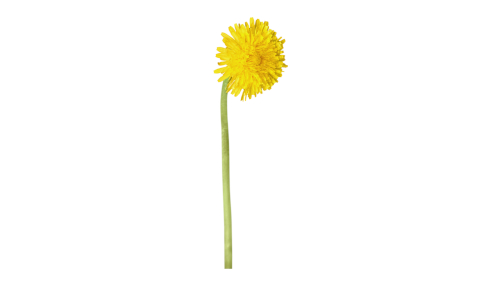
Each flower grows from a single stem which is a hollow stalk. That’s an important distinction because some lookalikes have multiple flowers growing from one stem.
Each flower is actually hundreds of individual flowers. We refer to this as a composite flower.
At the bottom of each flower there are pointy green bracts. These bracts often have a bitter flavor and so they are typically removed when preparing the flowers as food.
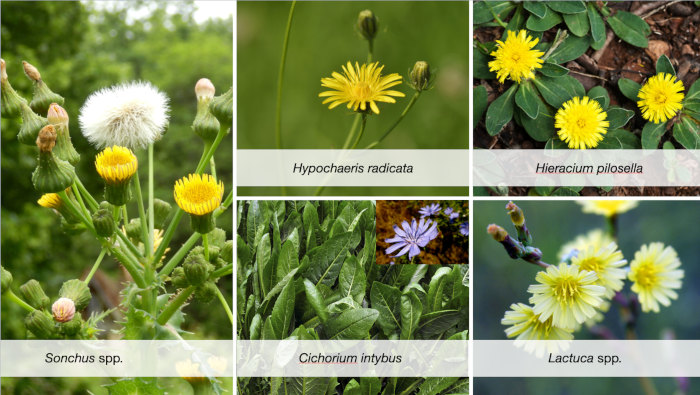
When you’re learning how to recognize dandelion it’s helpful to be familiar with common look-like plants, which include cat’s ear, hawkweed, sow thistle, chicory , and young wild lettuce.
Dandelion Benefits: Ecological Connections
Many beings rely on dandelion for food, ranging from small insects to mammals, including rabbits, groundhogs, pocket gophers, deer, elk, and even bears. The flowers provide nectar and pollen to insects such as honeybees, native bees, bee flies, and hoverflies. After the blooms have gone, small birds are known to eat the seeds.
Dandelion Benefits: How to Harvest Dandelions
Leaves and flowers can be gathered by hand or with scissors throughout the growing season. The leaves are best when young, as they become more bitter and tough as they age. There’s no set rule as to when they are tasty and when they’re not. Look for visibly young leaves then nibble some to let your taste buds decide.
Flowers and buds can be used whenever they’re available.
The flowers will readily go to seed, so it’s best to harvest them and then use them immediately. When harvesting flowers, keep in mind that they provide early spring food for bees and other insects.
Harvest safely! Every year billions of dollars are spent on herbicides attempting to eradicate the dandelion. Harvest dandelions in an area that hasn’t been poisoned for at least three years and is free of heavy metals.
As I’ve mentioned, dandelion leaves and flowers are an edible, nutrient-dense, and delicious food. For this next part of the video I am going to share my favorite recipes for them both. And, to make things easier on you, I’ve created a free recipe download with these same recipes. You can get your copy by using the link in the video description.
Dandelion Benefits: Dandelion Leaves Recipes
The first step in adding dandelion leaves to your meals is to taste the leaves. Leaves can vary in bitterness; some may taste slightly bitter but still yummy while others can be over-the-top bitter. So give your dandelion leaves a taste to see where they fall on the scale.
Hands down my favorite recipe for dandelion leaves is dandelion pesto. The bitterness of the leaves is mellowed with the salt and lemon in the recipe, and the garlic gives it an extra yummy punch.
Dandelion greens are high in minerals so I like to extract them in vinegar. In your recipe handouts I’ve included a recipe for a spring greens vinegar tonic.
The fresh greens can also be added to salads or sauteed as you would any green.
In our book, Wild Remedies: How to Forage Healing Foods and Craft Your Own Herbal Medicine, Emily Han and I have an entire chapter on dandelion leaves and flowers, and there’s a yummy recipe for Dandelion Greens on Socca bread.
Dandelion Flowers Recipes
The beautiful yellow blooms of dandelions are a fun addition to springtime foods. As a reminder, dandelion flowers need to be used as soon as they are harvested. Otherwise, they can close up and even go to seed before you get started. Make sure you have a plan and all ingredients available before you harvest.
Dandelion flowers can be enjoyed in many ways! They can be made into jelly, fermented into wine, or added to baked goods. I like spreading the broken up flowers onto salads or other meals as a beautiful garnish.
One of the most popular dandelion recipes I’ve written was Dandelion Maple Syrup Cake. This recipe is featured in our book, Wild Remedies, but I’ve also created a handout for you which includes this recipe.
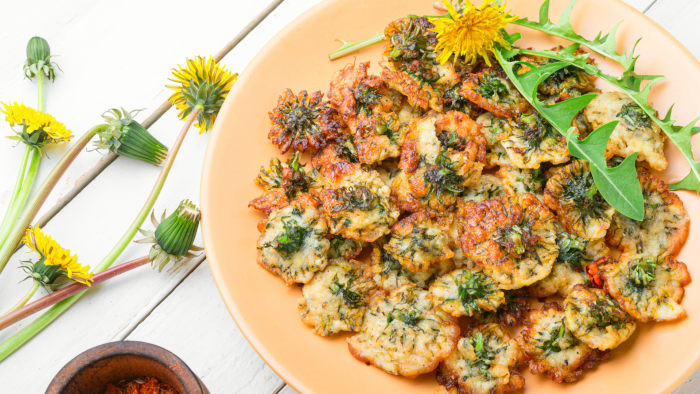
Dandelion Fritters may not be the healthiest dandelion flower recipe out there, but it’s yummy. To make these you dip the flowers in a simple batter and then fry the flowers in a high heat oil like avocado oil.
My success is seeing your success! That’s why I like to share recipes, so you can have your own herbal experiences. As a reminder you can get recipe cards for each of these yummy treats by using the link at the top of this page.
If you enjoyed this video on dandelion benefits and dandelion recipes and you value trusted herbal information, then I hope you’ll stick around! The best way to get started is to join my herbal community and get my weekly newsletters with my best herbal insights and tips!
You'll also get access to my free Herbal Jumpstart Course.
Click here to sign up.
And if you'd like to read more about dandelion benefits, read my full monograph on the dandelion herb benefits here!
Citations for Dandelion Benefits and Dandelion Recipes
Click to show/hide.

Rosalee is an herbalist and author of the bestselling book Alchemy of Herbs: Transform Everyday Ingredients Into Foods & Remedies That Healand co-author of the bestselling book Wild Remedies: How to Forage Healing Foods and Craft Your Own Herbal Medicine. She's a registered herbalist with the American Herbalist Guild and has taught thousands of students through her online courses. Read about how Rosalee went from having a terminal illness to being a bestselling author in her full story here.
